AACDS Unit 1.1 Tutorial Activity Workbook Part B: Light Therapies
VerifiedAdded on 2019/09/25
|14
|2425
|832
Homework Assignment
AI Summary
This workbook is a comprehensive tutorial activity guide for students studying the Advanced Diploma of Cosmetic Dermal Science, focusing on light-based therapies and IPL/Laser safety. It comprises eight activities covering topics such as absorption coefficients, laser and light physics, IPL permanent hair reduction, Fitzpatrick skin classification, photo rejuvenation, infrared, radiofrequency, and LED technology, mock incident reports, and IPL/Laser safety protocols. The workbook includes questions, case studies, and practical exercises to reinforce learning and prepare students for examinations. The activities assess understanding of key concepts, including chromophore targeting, treatment contraindications, and safety measures. Students are prompted to analyze scenarios, complete tables, and create incident reports, demonstrating their ability to apply theoretical knowledge to real-world situations within the cosmetic dermal science field. The workbook emphasizes the importance of patient safety, appropriate treatment protocols, and effective communication. The student is required to submit the completed workbook to their assessor prior to completing the part B exam.
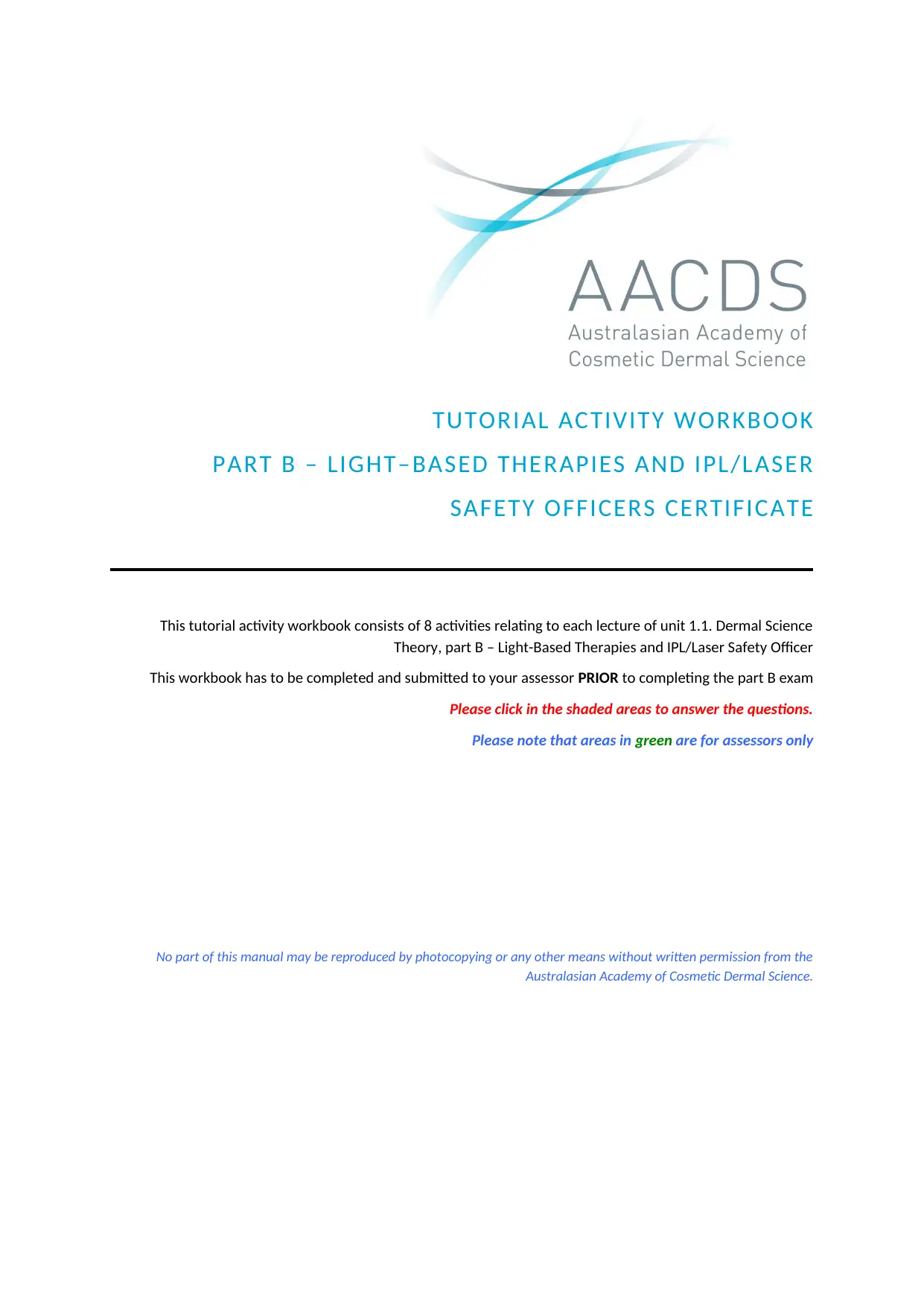
TUTORIAL ACTIVITY WORKBOOK
PART B – LIGHT–BASED THERAPIES AND IPL/LASER
SAFETY OFFICERS CERTIFICATE
This tutorial activity workbook consists of 8 activities relating to each lecture of unit 1.1. Dermal Science
Theory, part B – Light-Based Therapies and IPL/Laser Safety Officer
This workbook has to be completed and submitted to your assessor PRIOR to completing the part B exam
Please click in the shaded areas to answer the questions.
Please note that areas in green are for assessors only
No part of this manual may be reproduced by photocopying or any other means without written permission from the
Australasian Academy of Cosmetic Dermal Science.
PART B – LIGHT–BASED THERAPIES AND IPL/LASER
SAFETY OFFICERS CERTIFICATE
This tutorial activity workbook consists of 8 activities relating to each lecture of unit 1.1. Dermal Science
Theory, part B – Light-Based Therapies and IPL/Laser Safety Officer
This workbook has to be completed and submitted to your assessor PRIOR to completing the part B exam
Please click in the shaded areas to answer the questions.
Please note that areas in green are for assessors only
No part of this manual may be reproduced by photocopying or any other means without written permission from the
Australasian Academy of Cosmetic Dermal Science.
Paraphrase This Document
Need a fresh take? Get an instant paraphrase of this document with our AI Paraphraser
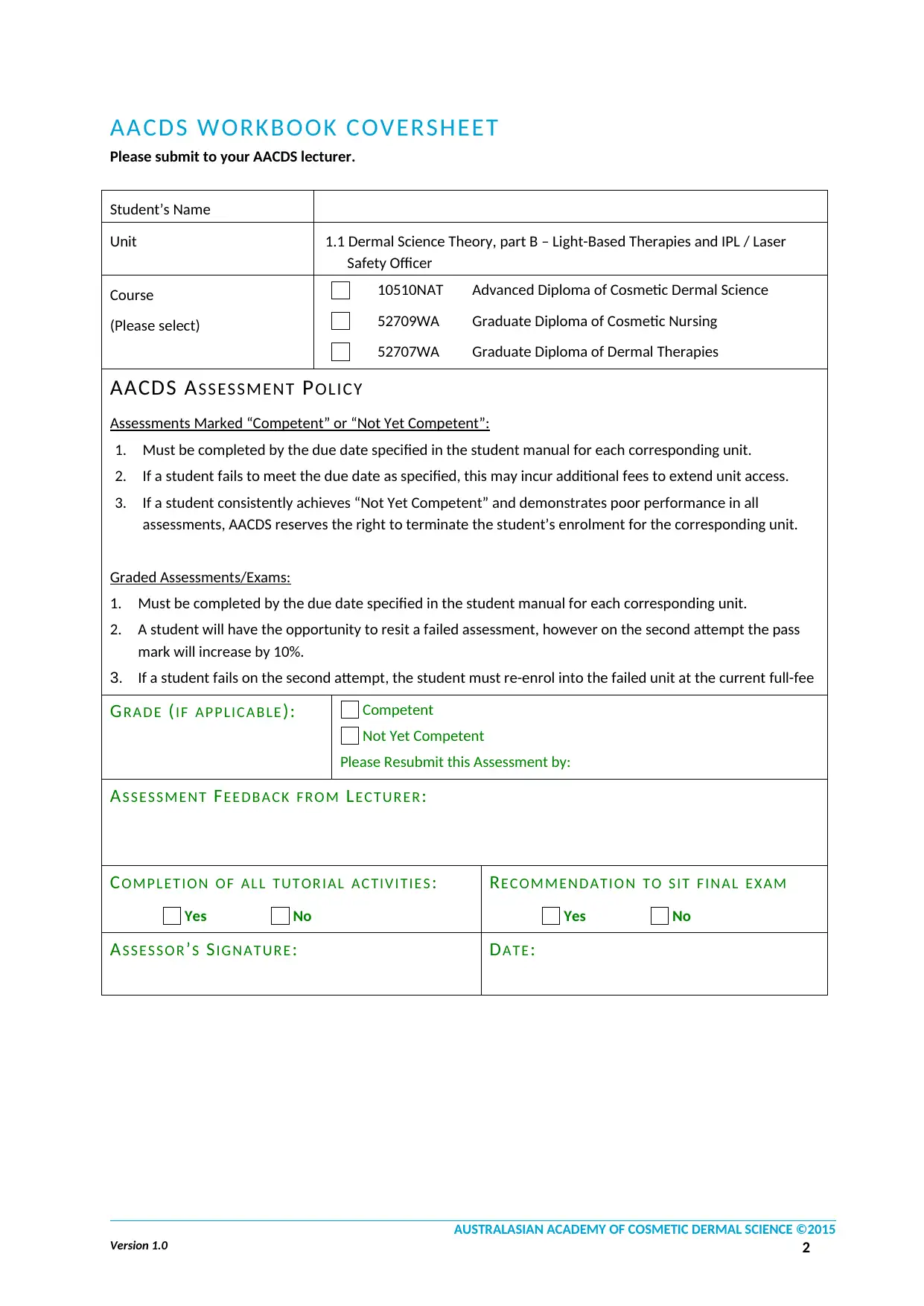
AACDS WORKBOOK COVERSHEET
Please submit to your AACDS lecturer.
Student’s Name
Unit 1.1 Dermal Science Theory, part B – Light-Based Therapies and IPL / Laser
Safety Officer
Course
(Please select)
10510NAT Advanced Diploma of Cosmetic Dermal Science
52709WA Graduate Diploma of Cosmetic Nursing
52707WA Graduate Diploma of Dermal Therapies
AACDS ASSESSMENT POLICY
Assessments Marked “Competent” or “Not Yet Competent”:
1. Must be completed by the due date specified in the student manual for each corresponding unit.
2. If a student fails to meet the due date as specified, this may incur additional fees to extend unit access.
3. If a student consistently achieves “Not Yet Competent” and demonstrates poor performance in all
assessments, AACDS reserves the right to terminate the student’s enrolment for the corresponding unit.
Graded Assessments/Exams:
1. Must be completed by the due date specified in the student manual for each corresponding unit.
2. A student will have the opportunity to resit a failed assessment, however on the second attempt the pass
mark will increase by 10%.
3. If a student fails on the second attempt, the student must re-enrol into the failed unit at the current full-fee
GR A D E (I F AP P LICA BLE ): Competent
Not Yet Competent
Please Resubmit this Assessment by:
AS S E S S M E N T FE E D BA CK F R O M LE CT UR E R :
COM P LE T I O N OF AL L T UT OR IAL AC TIV IT IE S :
Yes No
RE COM M E N D AT IO N T O S IT F IN A L E X AM
Yes No
AS S E S S O R ’S SIG N AT UR E : DAT E :
AUSTRALASIAN ACADEMY OF COSMETIC DERMAL SCIENCE ©2015
Version 1.0 2
Please submit to your AACDS lecturer.
Student’s Name
Unit 1.1 Dermal Science Theory, part B – Light-Based Therapies and IPL / Laser
Safety Officer
Course
(Please select)
10510NAT Advanced Diploma of Cosmetic Dermal Science
52709WA Graduate Diploma of Cosmetic Nursing
52707WA Graduate Diploma of Dermal Therapies
AACDS ASSESSMENT POLICY
Assessments Marked “Competent” or “Not Yet Competent”:
1. Must be completed by the due date specified in the student manual for each corresponding unit.
2. If a student fails to meet the due date as specified, this may incur additional fees to extend unit access.
3. If a student consistently achieves “Not Yet Competent” and demonstrates poor performance in all
assessments, AACDS reserves the right to terminate the student’s enrolment for the corresponding unit.
Graded Assessments/Exams:
1. Must be completed by the due date specified in the student manual for each corresponding unit.
2. A student will have the opportunity to resit a failed assessment, however on the second attempt the pass
mark will increase by 10%.
3. If a student fails on the second attempt, the student must re-enrol into the failed unit at the current full-fee
GR A D E (I F AP P LICA BLE ): Competent
Not Yet Competent
Please Resubmit this Assessment by:
AS S E S S M E N T FE E D BA CK F R O M LE CT UR E R :
COM P LE T I O N OF AL L T UT OR IAL AC TIV IT IE S :
Yes No
RE COM M E N D AT IO N T O S IT F IN A L E X AM
Yes No
AS S E S S O R ’S SIG N AT UR E : DAT E :
AUSTRALASIAN ACADEMY OF COSMETIC DERMAL SCIENCE ©2015
Version 1.0 2
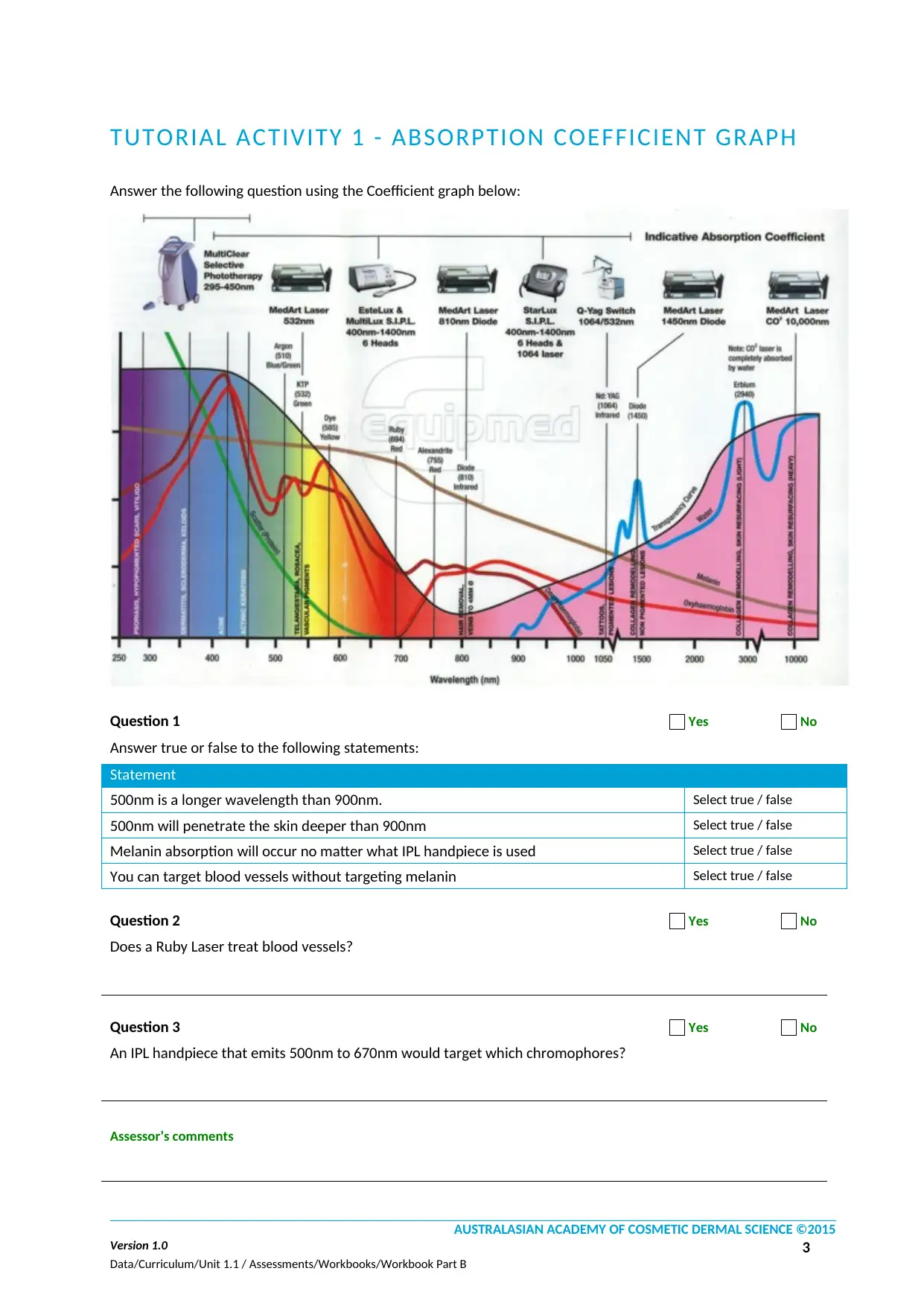
TUTORIAL ACTIVITY 1 - ABSORPTION COEFFICIENT GRAPH
Answer the following question using the Coefficient graph below:
Question 1 Yes No
Answer true or false to the following statements:
Statement
500nm is a longer wavelength than 900nm. Select true / false
500nm will penetrate the skin deeper than 900nm Select true / false
Melanin absorption will occur no matter what IPL handpiece is used Select true / false
You can target blood vessels without targeting melanin Select true / false
Question 2 Yes No
Does a Ruby Laser treat blood vessels?
Question 3 Yes No
An IPL handpiece that emits 500nm to 670nm would target which chromophores?
Assessor’s comments
AUSTRALASIAN ACADEMY OF COSMETIC DERMAL SCIENCE ©2015
Version 1.0 3
Data/Curriculum/Unit 1.1 / Assessments/Workbooks/Workbook Part B
Answer the following question using the Coefficient graph below:
Question 1 Yes No
Answer true or false to the following statements:
Statement
500nm is a longer wavelength than 900nm. Select true / false
500nm will penetrate the skin deeper than 900nm Select true / false
Melanin absorption will occur no matter what IPL handpiece is used Select true / false
You can target blood vessels without targeting melanin Select true / false
Question 2 Yes No
Does a Ruby Laser treat blood vessels?
Question 3 Yes No
An IPL handpiece that emits 500nm to 670nm would target which chromophores?
Assessor’s comments
AUSTRALASIAN ACADEMY OF COSMETIC DERMAL SCIENCE ©2015
Version 1.0 3
Data/Curriculum/Unit 1.1 / Assessments/Workbooks/Workbook Part B
⊘ This is a preview!⊘
Do you want full access?
Subscribe today to unlock all pages.

Trusted by 1+ million students worldwide
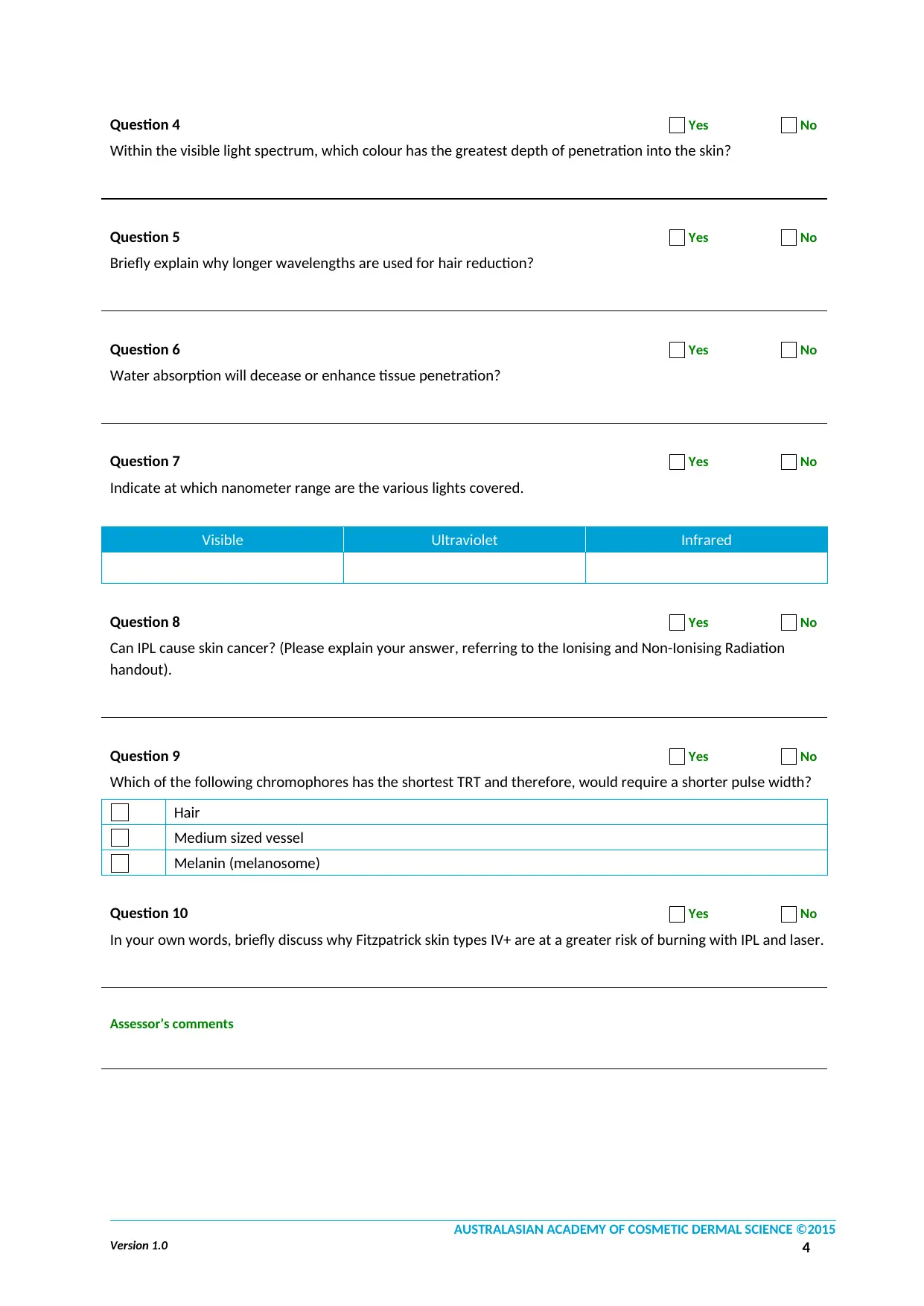
Question 4 Yes No
Within the visible light spectrum, which colour has the greatest depth of penetration into the skin?
Question 5 Yes No
Briefly explain why longer wavelengths are used for hair reduction?
Question 6 Yes No
Water absorption will decease or enhance tissue penetration?
Question 7 Yes No
Indicate at which nanometer range are the various lights covered.
Visible Ultraviolet Infrared
Question 8 Yes No
Can IPL cause skin cancer? (Please explain your answer, referring to the Ionising and Non-Ionising Radiation
handout).
Question 9 Yes No
Which of the following chromophores has the shortest TRT and therefore, would require a shorter pulse width?
Hair
Medium sized vessel
Melanin (melanosome)
Question 10 Yes No
In your own words, briefly discuss why Fitzpatrick skin types IV+ are at a greater risk of burning with IPL and laser.
Assessor’s comments
AUSTRALASIAN ACADEMY OF COSMETIC DERMAL SCIENCE ©2015
Version 1.0 4
Within the visible light spectrum, which colour has the greatest depth of penetration into the skin?
Question 5 Yes No
Briefly explain why longer wavelengths are used for hair reduction?
Question 6 Yes No
Water absorption will decease or enhance tissue penetration?
Question 7 Yes No
Indicate at which nanometer range are the various lights covered.
Visible Ultraviolet Infrared
Question 8 Yes No
Can IPL cause skin cancer? (Please explain your answer, referring to the Ionising and Non-Ionising Radiation
handout).
Question 9 Yes No
Which of the following chromophores has the shortest TRT and therefore, would require a shorter pulse width?
Hair
Medium sized vessel
Melanin (melanosome)
Question 10 Yes No
In your own words, briefly discuss why Fitzpatrick skin types IV+ are at a greater risk of burning with IPL and laser.
Assessor’s comments
AUSTRALASIAN ACADEMY OF COSMETIC DERMAL SCIENCE ©2015
Version 1.0 4
Paraphrase This Document
Need a fresh take? Get an instant paraphrase of this document with our AI Paraphraser
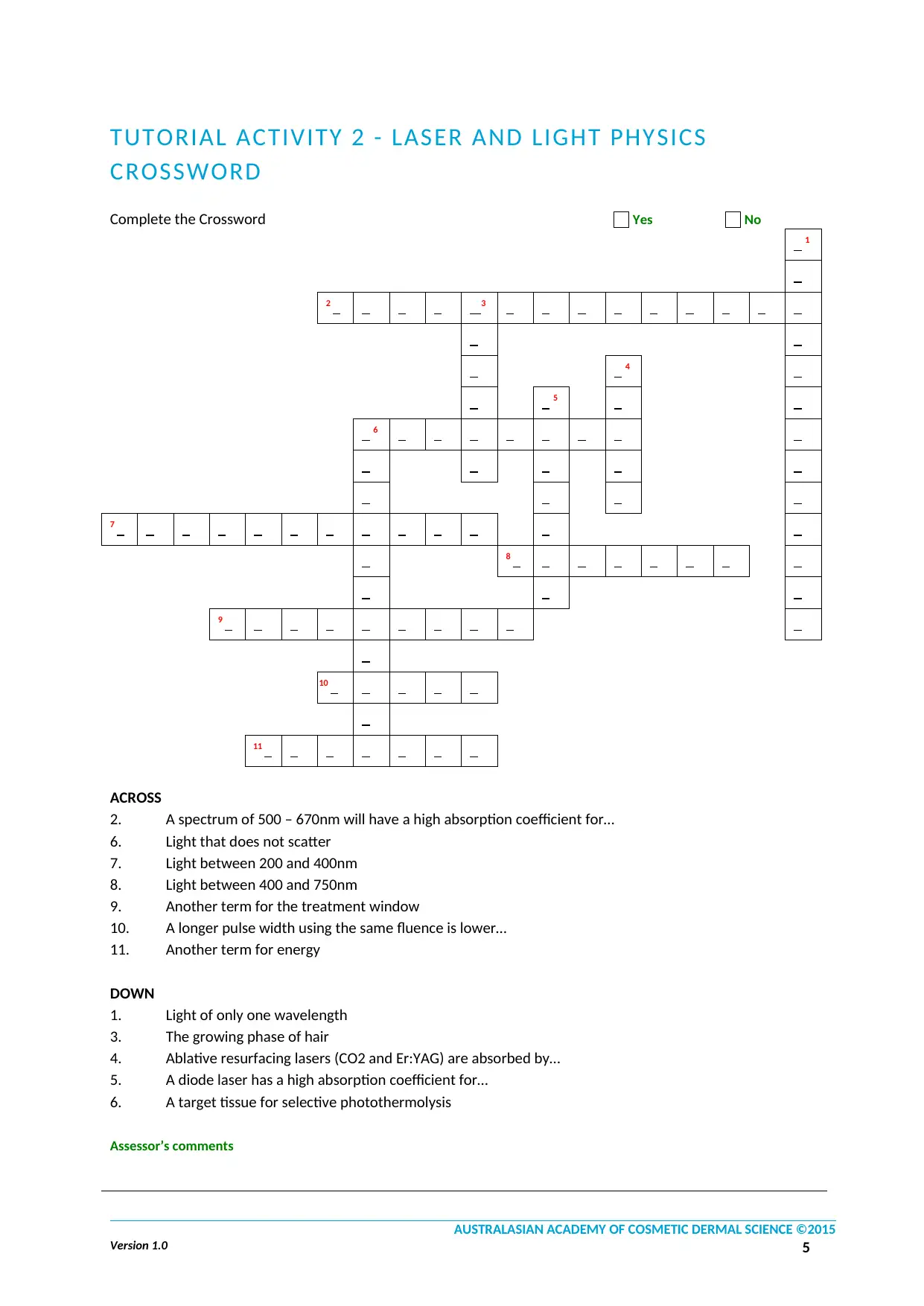
TUTORIAL ACTIVITY 2 - LASER AND LIGHT PHYSICS
CROSSWORD
Complete the Crossword Yes No
1
2 3
4
5
6
7
8
9
10
11
ACROSS
2. A spectrum of 500 – 670nm will have a high absorption coefficient for…
6. Light that does not scatter
7. Light between 200 and 400nm
8. Light between 400 and 750nm
9. Another term for the treatment window
10. A longer pulse width using the same fluence is lower…
11. Another term for energy
DOWN
1. Light of only one wavelength
3. The growing phase of hair
4. Ablative resurfacing lasers (CO2 and Er:YAG) are absorbed by…
5. A diode laser has a high absorption coefficient for…
6. A target tissue for selective photothermolysis
Assessor’s comments
AUSTRALASIAN ACADEMY OF COSMETIC DERMAL SCIENCE ©2015
Version 1.0 5
CROSSWORD
Complete the Crossword Yes No
1
2 3
4
5
6
7
8
9
10
11
ACROSS
2. A spectrum of 500 – 670nm will have a high absorption coefficient for…
6. Light that does not scatter
7. Light between 200 and 400nm
8. Light between 400 and 750nm
9. Another term for the treatment window
10. A longer pulse width using the same fluence is lower…
11. Another term for energy
DOWN
1. Light of only one wavelength
3. The growing phase of hair
4. Ablative resurfacing lasers (CO2 and Er:YAG) are absorbed by…
5. A diode laser has a high absorption coefficient for…
6. A target tissue for selective photothermolysis
Assessor’s comments
AUSTRALASIAN ACADEMY OF COSMETIC DERMAL SCIENCE ©2015
Version 1.0 5
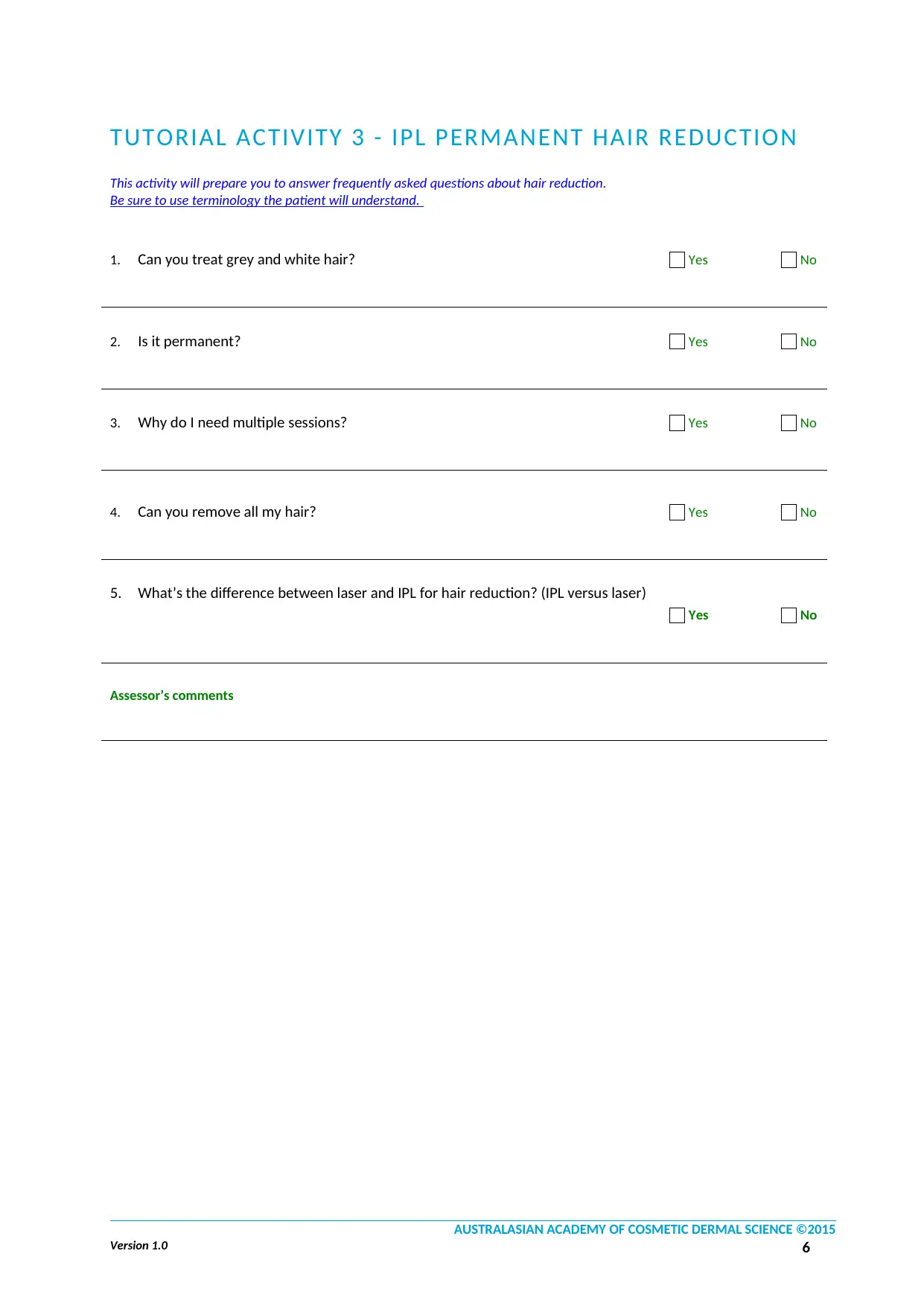
TUTORIAL ACTIVITY 3 - IPL PERMANENT HAIR REDUCTION
This activity will prepare you to answer frequently asked questions about hair reduction.
Be sure to use terminology the patient will understand.
1. Can you treat grey and white hair? Yes No
2. Is it permanent? Yes No
3. Why do I need multiple sessions? Yes No
4. Can you remove all my hair? Yes No
5. What’s the difference between laser and IPL for hair reduction? (IPL versus laser)
Yes No
Assessor’s comments
AUSTRALASIAN ACADEMY OF COSMETIC DERMAL SCIENCE ©2015
Version 1.0 6
This activity will prepare you to answer frequently asked questions about hair reduction.
Be sure to use terminology the patient will understand.
1. Can you treat grey and white hair? Yes No
2. Is it permanent? Yes No
3. Why do I need multiple sessions? Yes No
4. Can you remove all my hair? Yes No
5. What’s the difference between laser and IPL for hair reduction? (IPL versus laser)
Yes No
Assessor’s comments
AUSTRALASIAN ACADEMY OF COSMETIC DERMAL SCIENCE ©2015
Version 1.0 6
⊘ This is a preview!⊘
Do you want full access?
Subscribe today to unlock all pages.

Trusted by 1+ million students worldwide
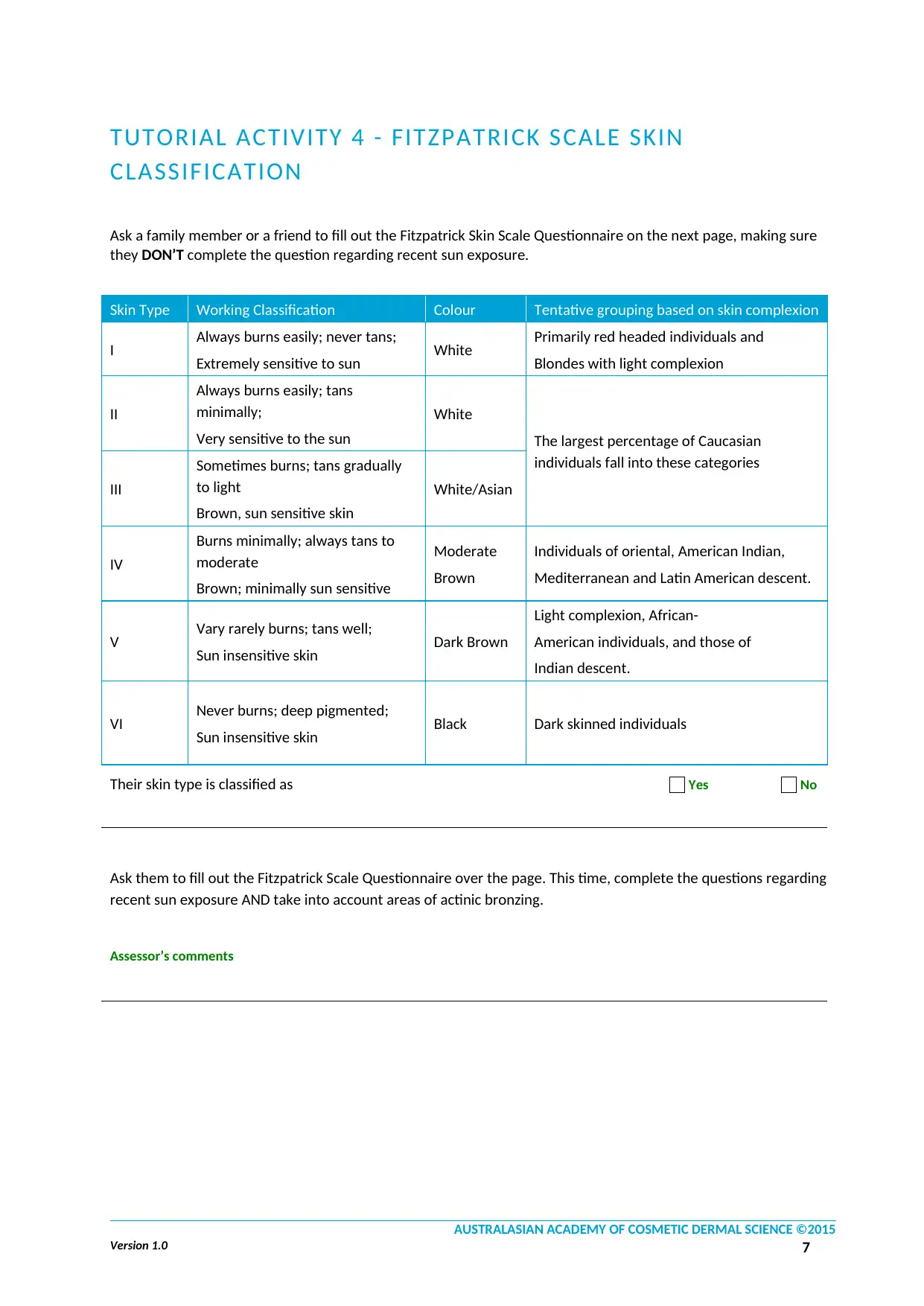
TUTORIAL ACTIVITY 4 - FITZPATRICK SCALE SKIN
CLASSIFICATION
Ask a family member or a friend to fill out the Fitzpatrick Skin Scale Questionnaire on the next page, making sure
they DON’T complete the question regarding recent sun exposure.
Skin Type Working Classification Colour Tentative grouping based on skin complexion
I Always burns easily; never tans;
Extremely sensitive to sun White Primarily red headed individuals and
Blondes with light complexion
II
Always burns easily; tans
minimally;
Very sensitive to the sun
White
The largest percentage of Caucasian
individuals fall into these categories
III
Sometimes burns; tans gradually
to light
Brown, sun sensitive skin
White/Asian
IV
Burns minimally; always tans to
moderate
Brown; minimally sun sensitive
Moderate
Brown
Individuals of oriental, American Indian,
Mediterranean and Latin American descent.
V Vary rarely burns; tans well;
Sun insensitive skin Dark Brown
Light complexion, African-
American individuals, and those of
Indian descent.
VI Never burns; deep pigmented;
Sun insensitive skin Black Dark skinned individuals
Their skin type is classified as Yes No
Ask them to fill out the Fitzpatrick Scale Questionnaire over the page. This time, complete the questions regarding
recent sun exposure AND take into account areas of actinic bronzing.
Assessor’s comments
AUSTRALASIAN ACADEMY OF COSMETIC DERMAL SCIENCE ©2015
Version 1.0 7
CLASSIFICATION
Ask a family member or a friend to fill out the Fitzpatrick Skin Scale Questionnaire on the next page, making sure
they DON’T complete the question regarding recent sun exposure.
Skin Type Working Classification Colour Tentative grouping based on skin complexion
I Always burns easily; never tans;
Extremely sensitive to sun White Primarily red headed individuals and
Blondes with light complexion
II
Always burns easily; tans
minimally;
Very sensitive to the sun
White
The largest percentage of Caucasian
individuals fall into these categories
III
Sometimes burns; tans gradually
to light
Brown, sun sensitive skin
White/Asian
IV
Burns minimally; always tans to
moderate
Brown; minimally sun sensitive
Moderate
Brown
Individuals of oriental, American Indian,
Mediterranean and Latin American descent.
V Vary rarely burns; tans well;
Sun insensitive skin Dark Brown
Light complexion, African-
American individuals, and those of
Indian descent.
VI Never burns; deep pigmented;
Sun insensitive skin Black Dark skinned individuals
Their skin type is classified as Yes No
Ask them to fill out the Fitzpatrick Scale Questionnaire over the page. This time, complete the questions regarding
recent sun exposure AND take into account areas of actinic bronzing.
Assessor’s comments
AUSTRALASIAN ACADEMY OF COSMETIC DERMAL SCIENCE ©2015
Version 1.0 7
Paraphrase This Document
Need a fresh take? Get an instant paraphrase of this document with our AI Paraphraser
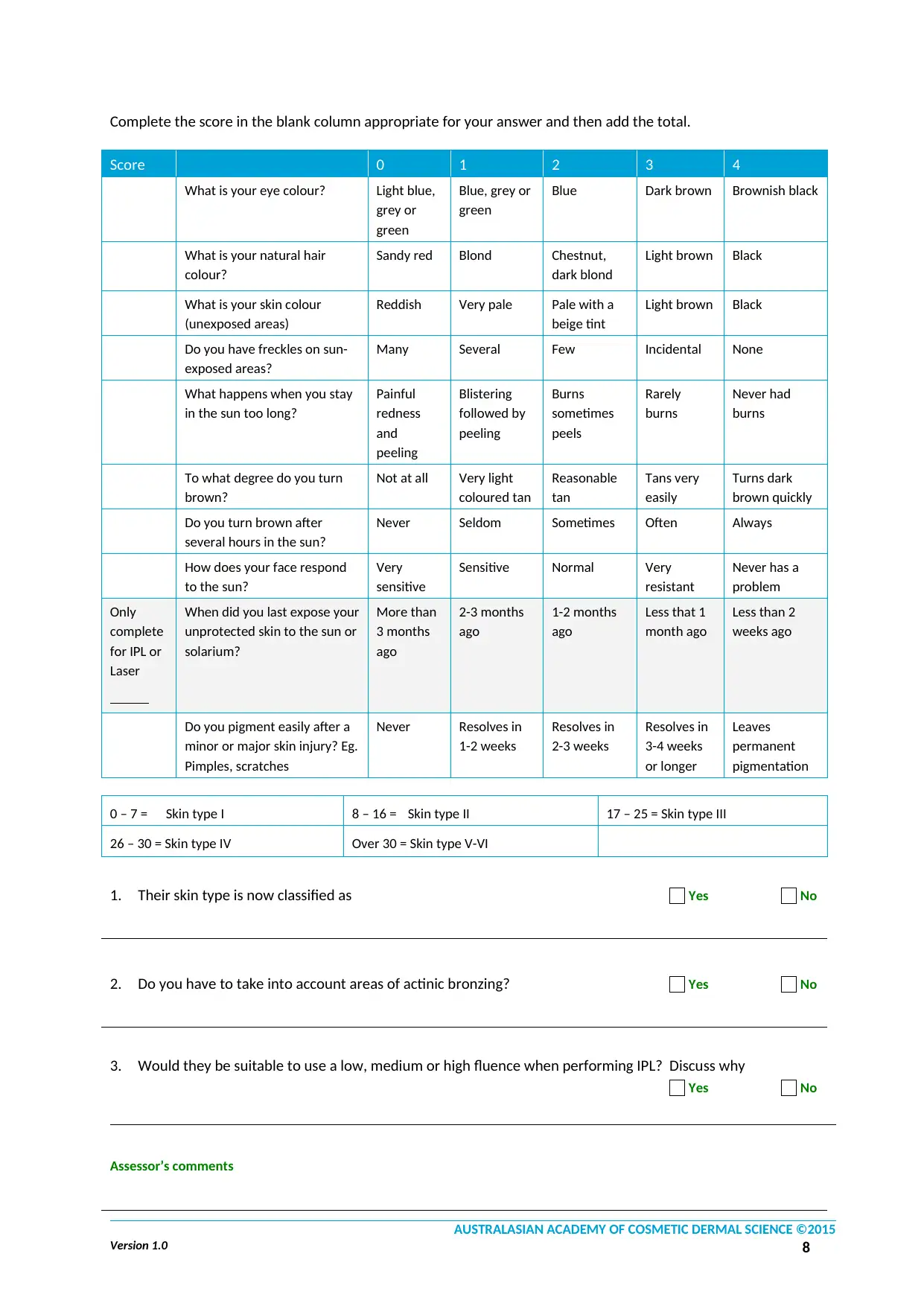
Complete the score in the blank column appropriate for your answer and then add the total.
Score 0 1 2 3 4
What is your eye colour? Light blue,
grey or
green
Blue, grey or
green
Blue Dark brown Brownish black
What is your natural hair
colour?
Sandy red Blond Chestnut,
dark blond
Light brown Black
What is your skin colour
(unexposed areas)
Reddish Very pale Pale with a
beige tint
Light brown Black
Do you have freckles on sun-
exposed areas?
Many Several Few Incidental None
What happens when you stay
in the sun too long?
Painful
redness
and
peeling
Blistering
followed by
peeling
Burns
sometimes
peels
Rarely
burns
Never had
burns
To what degree do you turn
brown?
Not at all Very light
coloured tan
Reasonable
tan
Tans very
easily
Turns dark
brown quickly
Do you turn brown after
several hours in the sun?
Never Seldom Sometimes Often Always
How does your face respond
to the sun?
Very
sensitive
Sensitive Normal Very
resistant
Never has a
problem
Only
complete
for IPL or
Laser
When did you last expose your
unprotected skin to the sun or
solarium?
More than
3 months
ago
2-3 months
ago
1-2 months
ago
Less that 1
month ago
Less than 2
weeks ago
Do you pigment easily after a
minor or major skin injury? Eg.
Pimples, scratches
Never Resolves in
1-2 weeks
Resolves in
2-3 weeks
Resolves in
3-4 weeks
or longer
Leaves
permanent
pigmentation
0 – 7 = Skin type I 8 – 16 = Skin type II 17 – 25 = Skin type III
26 – 30 = Skin type IV Over 30 = Skin type V-VI
1. Their skin type is now classified as Yes No
2. Do you have to take into account areas of actinic bronzing? Yes No
3. Would they be suitable to use a low, medium or high fluence when performing IPL? Discuss why
Yes No
Assessor’s comments
AUSTRALASIAN ACADEMY OF COSMETIC DERMAL SCIENCE ©2015
Version 1.0 8
Score 0 1 2 3 4
What is your eye colour? Light blue,
grey or
green
Blue, grey or
green
Blue Dark brown Brownish black
What is your natural hair
colour?
Sandy red Blond Chestnut,
dark blond
Light brown Black
What is your skin colour
(unexposed areas)
Reddish Very pale Pale with a
beige tint
Light brown Black
Do you have freckles on sun-
exposed areas?
Many Several Few Incidental None
What happens when you stay
in the sun too long?
Painful
redness
and
peeling
Blistering
followed by
peeling
Burns
sometimes
peels
Rarely
burns
Never had
burns
To what degree do you turn
brown?
Not at all Very light
coloured tan
Reasonable
tan
Tans very
easily
Turns dark
brown quickly
Do you turn brown after
several hours in the sun?
Never Seldom Sometimes Often Always
How does your face respond
to the sun?
Very
sensitive
Sensitive Normal Very
resistant
Never has a
problem
Only
complete
for IPL or
Laser
When did you last expose your
unprotected skin to the sun or
solarium?
More than
3 months
ago
2-3 months
ago
1-2 months
ago
Less that 1
month ago
Less than 2
weeks ago
Do you pigment easily after a
minor or major skin injury? Eg.
Pimples, scratches
Never Resolves in
1-2 weeks
Resolves in
2-3 weeks
Resolves in
3-4 weeks
or longer
Leaves
permanent
pigmentation
0 – 7 = Skin type I 8 – 16 = Skin type II 17 – 25 = Skin type III
26 – 30 = Skin type IV Over 30 = Skin type V-VI
1. Their skin type is now classified as Yes No
2. Do you have to take into account areas of actinic bronzing? Yes No
3. Would they be suitable to use a low, medium or high fluence when performing IPL? Discuss why
Yes No
Assessor’s comments
AUSTRALASIAN ACADEMY OF COSMETIC DERMAL SCIENCE ©2015
Version 1.0 8

AUSTRALASIAN ACADEMY OF COSMETIC DERMAL SCIENCE ©2015
Version 1.0 9
Version 1.0 9
⊘ This is a preview!⊘
Do you want full access?
Subscribe today to unlock all pages.

Trusted by 1+ million students worldwide
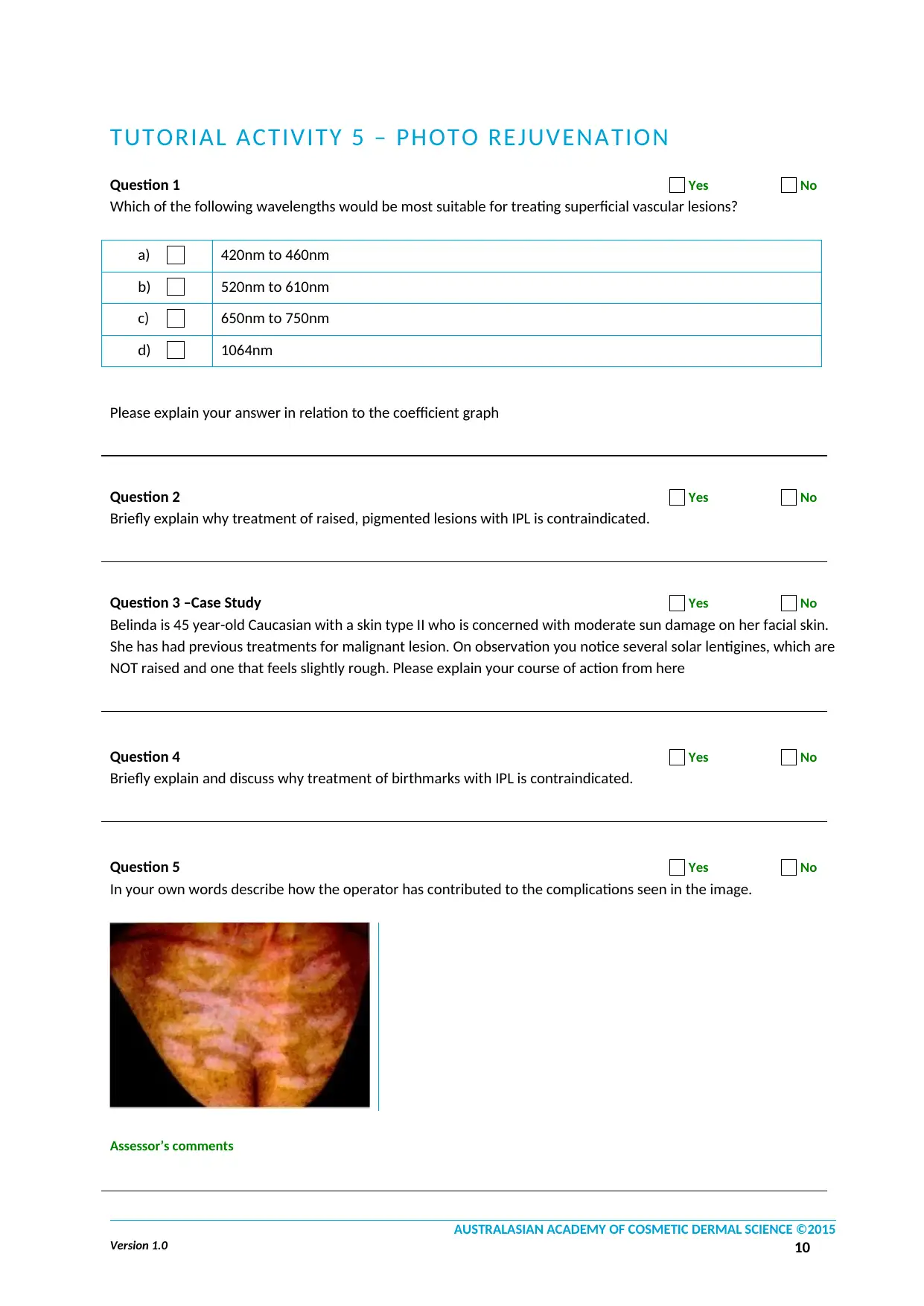
TUTORIAL ACTIVITY 5 – PHOTO REJUVENATION
Question 1 Yes No
Which of the following wavelengths would be most suitable for treating superficial vascular lesions?
a) 420nm to 460nm
b) 520nm to 610nm
c) 650nm to 750nm
d) 1064nm
Please explain your answer in relation to the coefficient graph
Question 2 Yes No
Briefly explain why treatment of raised, pigmented lesions with IPL is contraindicated.
Question 3 –Case Study Yes No
Belinda is 45 year-old Caucasian with a skin type II who is concerned with moderate sun damage on her facial skin.
She has had previous treatments for malignant lesion. On observation you notice several solar lentigines, which are
NOT raised and one that feels slightly rough. Please explain your course of action from here
Question 4 Yes No
Briefly explain and discuss why treatment of birthmarks with IPL is contraindicated.
Question 5 Yes No
In your own words describe how the operator has contributed to the complications seen in the image.
Assessor’s comments
AUSTRALASIAN ACADEMY OF COSMETIC DERMAL SCIENCE ©2015
Version 1.0 10
Question 1 Yes No
Which of the following wavelengths would be most suitable for treating superficial vascular lesions?
a) 420nm to 460nm
b) 520nm to 610nm
c) 650nm to 750nm
d) 1064nm
Please explain your answer in relation to the coefficient graph
Question 2 Yes No
Briefly explain why treatment of raised, pigmented lesions with IPL is contraindicated.
Question 3 –Case Study Yes No
Belinda is 45 year-old Caucasian with a skin type II who is concerned with moderate sun damage on her facial skin.
She has had previous treatments for malignant lesion. On observation you notice several solar lentigines, which are
NOT raised and one that feels slightly rough. Please explain your course of action from here
Question 4 Yes No
Briefly explain and discuss why treatment of birthmarks with IPL is contraindicated.
Question 5 Yes No
In your own words describe how the operator has contributed to the complications seen in the image.
Assessor’s comments
AUSTRALASIAN ACADEMY OF COSMETIC DERMAL SCIENCE ©2015
Version 1.0 10
Paraphrase This Document
Need a fresh take? Get an instant paraphrase of this document with our AI Paraphraser
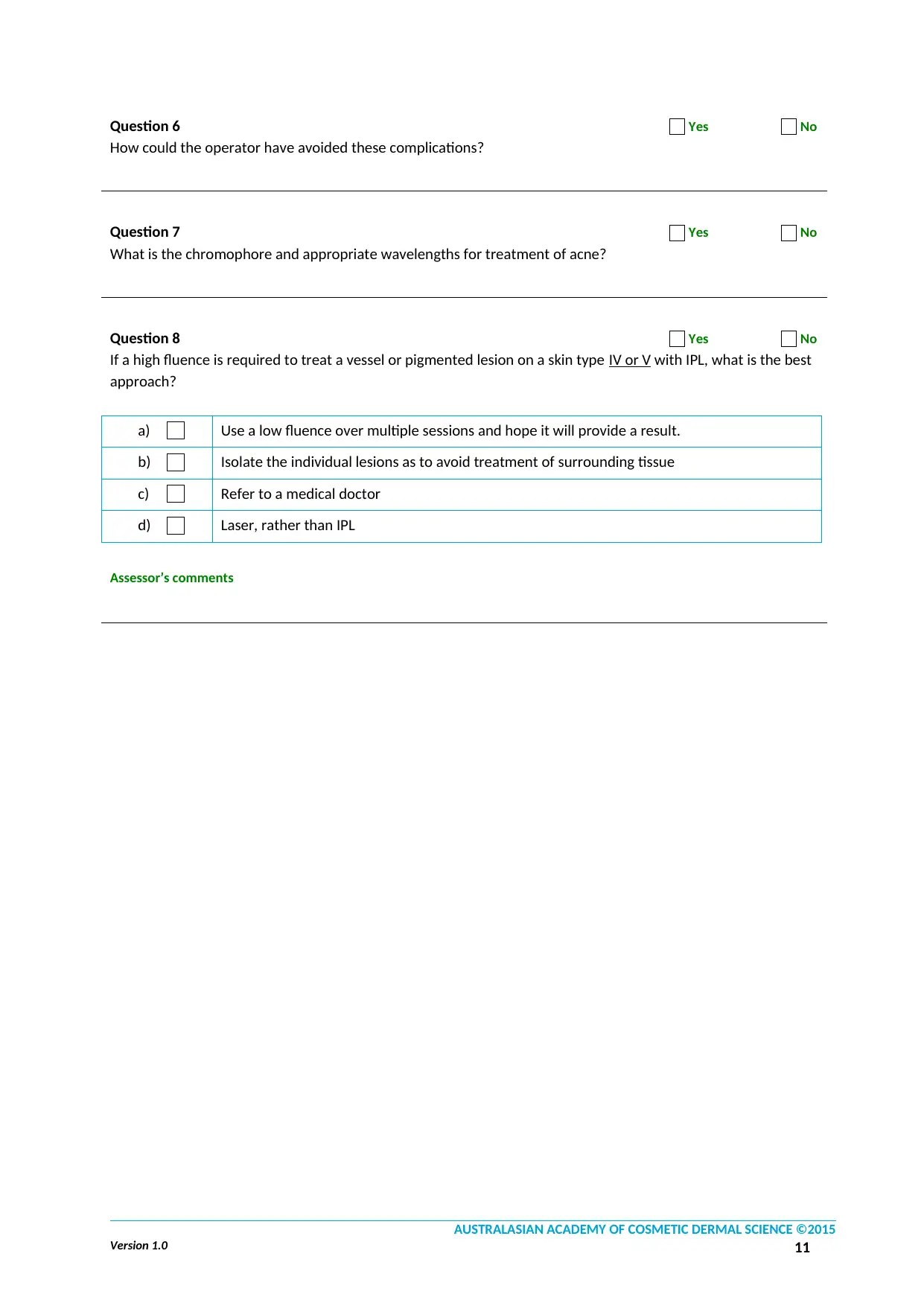
Question 6 Yes No
How could the operator have avoided these complications?
Question 7 Yes No
What is the chromophore and appropriate wavelengths for treatment of acne?
Question 8 Yes No
If a high fluence is required to treat a vessel or pigmented lesion on a skin type IV or V with IPL, what is the best
approach?
a) Use a low fluence over multiple sessions and hope it will provide a result.
b) Isolate the individual lesions as to avoid treatment of surrounding tissue
c) Refer to a medical doctor
d) Laser, rather than IPL
Assessor’s comments
AUSTRALASIAN ACADEMY OF COSMETIC DERMAL SCIENCE ©2015
Version 1.0 11
How could the operator have avoided these complications?
Question 7 Yes No
What is the chromophore and appropriate wavelengths for treatment of acne?
Question 8 Yes No
If a high fluence is required to treat a vessel or pigmented lesion on a skin type IV or V with IPL, what is the best
approach?
a) Use a low fluence over multiple sessions and hope it will provide a result.
b) Isolate the individual lesions as to avoid treatment of surrounding tissue
c) Refer to a medical doctor
d) Laser, rather than IPL
Assessor’s comments
AUSTRALASIAN ACADEMY OF COSMETIC DERMAL SCIENCE ©2015
Version 1.0 11
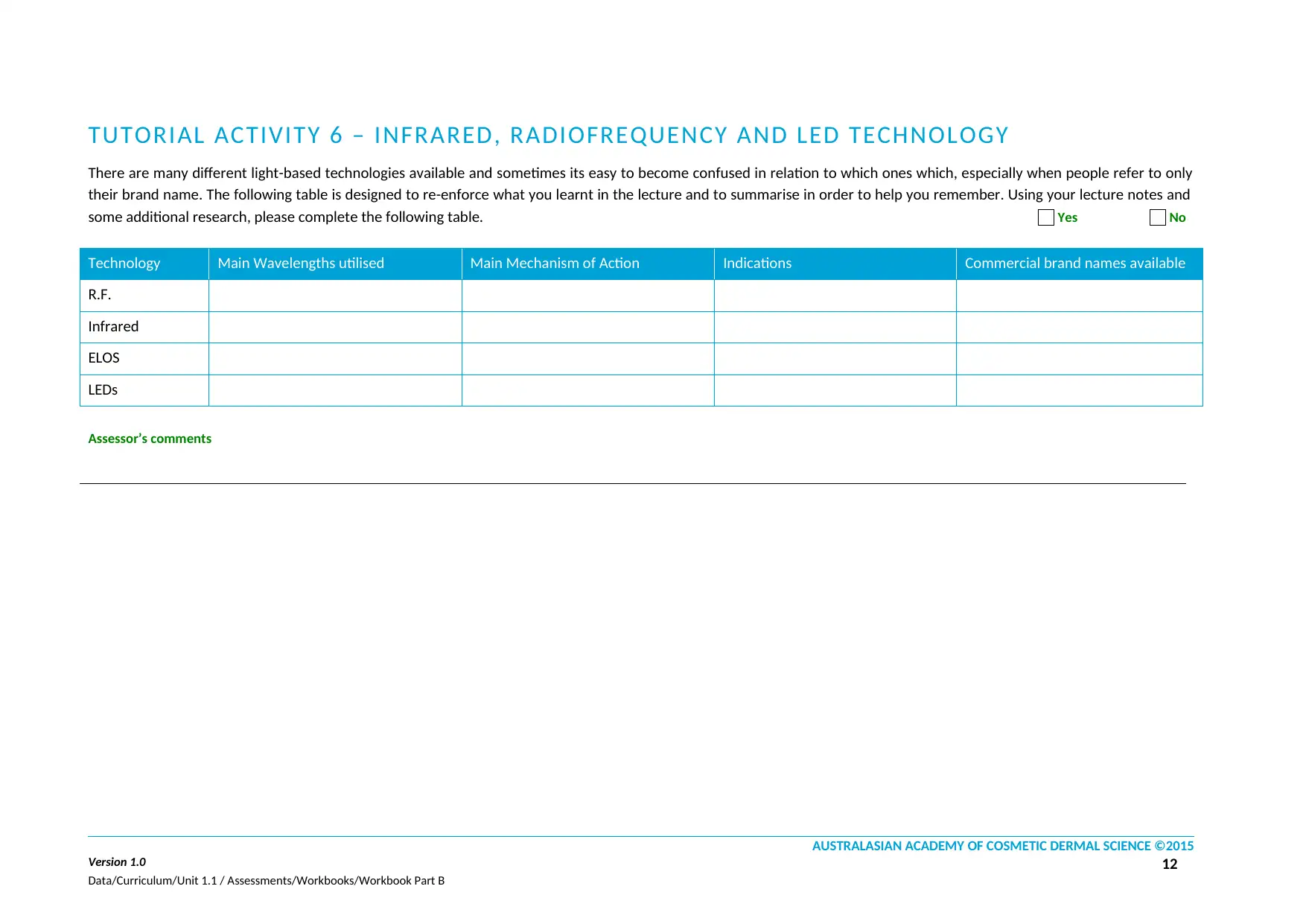
TUTORIAL ACTIVITY 6 – INFRARED, RADIOFREQUENCY AND LED TECHNOLOGY
There are many different light-based technologies available and sometimes its easy to become confused in relation to which ones which, especially when people refer to only
their brand name. The following table is designed to re-enforce what you learnt in the lecture and to summarise in order to help you remember. Using your lecture notes and
some additional research, please complete the following table. Yes No
Technology Main Wavelengths utilised Main Mechanism of Action Indications Commercial brand names available
R.F.
Infrared
ELOS
LEDs
Assessor’s comments
AUSTRALASIAN ACADEMY OF COSMETIC DERMAL SCIENCE ©2015
Version 1.0 12
Data/Curriculum/Unit 1.1 / Assessments/Workbooks/Workbook Part B
There are many different light-based technologies available and sometimes its easy to become confused in relation to which ones which, especially when people refer to only
their brand name. The following table is designed to re-enforce what you learnt in the lecture and to summarise in order to help you remember. Using your lecture notes and
some additional research, please complete the following table. Yes No
Technology Main Wavelengths utilised Main Mechanism of Action Indications Commercial brand names available
R.F.
Infrared
ELOS
LEDs
Assessor’s comments
AUSTRALASIAN ACADEMY OF COSMETIC DERMAL SCIENCE ©2015
Version 1.0 12
Data/Curriculum/Unit 1.1 / Assessments/Workbooks/Workbook Part B
⊘ This is a preview!⊘
Do you want full access?
Subscribe today to unlock all pages.

Trusted by 1+ million students worldwide
1 out of 14
Related Documents
Your All-in-One AI-Powered Toolkit for Academic Success.
+13062052269
info@desklib.com
Available 24*7 on WhatsApp / Email
![[object Object]](/_next/static/media/star-bottom.7253800d.svg)
Unlock your academic potential
Copyright © 2020–2025 A2Z Services. All Rights Reserved. Developed and managed by ZUCOL.





